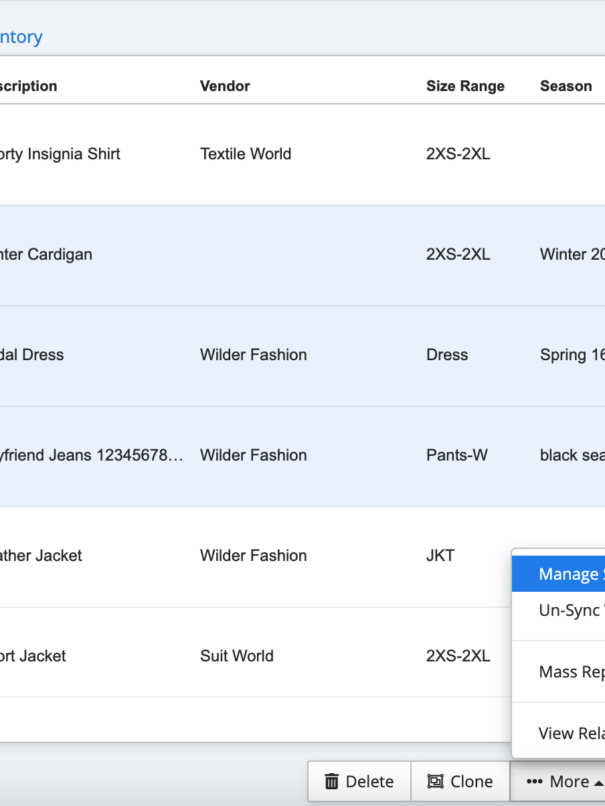In the fast-paced world of the apparel industry, inventory control management presents a myriad of challenges. Factors such as seasonality, the rise of fast fashion, and the constant demand for new and trendy products make managing inventory a complicated daily task.
Businesses must juggle current styles while anticipating future trends, all while competing in a global market. On top of that, they have to ensure customer satisfaction and completely eliminate human error during manual processes, as even the slightest of mistakes can cost them thousands of dollars. And it all comes down to keeping up with the latest trends and practices in the industry.
So, how exactly can apparel business owners overcome common inventory control challenges? Let’s explore how apparel businesses can make informed decisions and ensure effective inventory control management.
Addressing Excess Inventory: The Persistent Challenge
Excess stock, a recurring and significant issue, creates challenges in the realm of inventory management. Businesses with surplus inventory often find their available working capital severely limited. This could, in turn, compel companies to resort to markdowns or clearance sales, substantially eroding their profit margins.
The issue is further complicated by the need to maintain stocks of current fashion trends, coupled with the constant requirement to predict and prepare for the capricious nature of future fashion trends.
Strategy for Excess Inventory: Investing in Comprehensive Inventory Management Software
A pragmatic approach to conquering the hurdle of surplus inventory is investing in robust inventory management software solutions and tracking tools. These tools, equipped to provide real-time data and in-depth analysis, are pivotal in aiding businesses in monitoring market trends.
They allow for timely adjustments as required and help maintain a competitive edge in the swiftly changing landscape of the fashion industry.
A prime example of such a tool is the ApparelMagic ERP system. Not only does this system deliver real-time inventory tracking, but it also facilitates the management of new designs and raw materials, playing a crucial role in controlling excess stock effectively and efficiently.
Contending with High-level Competition: A Modern Reality
The modern age, marked by the emergence of fast fashion and ever-evolving consumer tastes, has given rise to an exceptionally competitive apparel industry.
These factors, functioning as catalysts, drive unpredictable market and economic fluctuations that have a profound impact on supply chains on a global scale.
Strategy for High Competition: Building Resilient Partnerships with Suppliers and Logistics Providers
In a fiercely competitive environment, it’s crucial for businesses to build resilient partnerships with suppliers and logistics providers. This allows for access to precise, real-time data about shipments and inventory levels.
Such crucial information can lead to better-informed decisions and facilitate quick responses to changes in consumer demand or unexpected market shifts.
Handling Perishable Inventory: A Unique Issue
Apparel inventory, characterized by a brief shelf life, introduces another layer of complexity to inventory management. From the moment an item enters inventory until it’s sold and lands in the customer’s hands, precise tracking is of the essence.
Strategy for Perishable Inventory: Streamlining the Packaging Process
A valuable strategy to manage perishable inventory more effectively involves streamlining the packaging process. This strategy requires optimizing warehouse space, equipment, and storage needs. It may involve decreasing the number of items in each shipment or using cutting-edge packaging materials. These measures can lead to decreased costs and smooth operations.

Overcoming Centralized Tracking Challenges: A Growing Necessity
The absence of centralized tracking can escalate the frequency of inventory errors and inflate operational costs. This is especially true as a business expands and becomes more dependent on accurate, real-time tracking.
Strategy for Tracking Challenges: Investment in Unified Inventory Management Platforms
Investing in inventory management platforms seamlessly integrating with existing business process software can alleviate these common challenges. Such systems are designed to simplify inventory management processes, save time, and minimize complications. The result is a framework ensuring accurate and updated inventory tracking.
Managing Multichannel Sales: An Emerging Complex Scenario
Multichannel sales, involving sales through multiple outlets such as physical stores, online stores, social media, etc., add layers of complexity to inventory control management. Each channel often has distinct customer demand patterns.
Strategy for Multichannel Sales: Adoption of Multichannel Sales Management Tools
In this complex scenario, adopting tools designed to manage multichannel sales effectively becomes crucial for modern apparel businesses. For instance, ApparelMagic’s order management feature is engineered to assist businesses in efficiently inputting orders from various channels.
This tool streamlines the pick-and-pack process, accelerates order approvals, prioritizes orders, and effectively handles backorders, thereby meeting customers’ demands across all channels.
Adapting to Global Business Requirements: A Rising Challenge in the Modern Business Landscape
Companies expanding their reach across borders encounter a new array of challenges. These challenges come in various forms, including managing multi-currency transactions and dealing with international date formatting, both of which can add another layer of complexity to the already intricate process of inventory control management.
The task of effectively navigating these unique complexities and ensuring a seamless operation across different regions can be daunting for businesses venturing into international markets.
Strategy for Global Challenges: The Necessity of Utilizing International Business Management Tools
Faced with global challenges, apparel businesses need to adopt a forward-thinking approach. One effective strategy is to utilize international business management tools designed to streamline processes and improve efficiency. Tools like ApparelMagic’s global business management module can play a pivotal role in this respect.
ApparelMagic’s global business management module has a wide range of features that specifically address these challenges. One of its standout features is the multi-currency capability. This allows businesses to transact in multiple currencies, a must-have feature for companies with a global customer base.
It facilitates the management of multiple sales channels in different currencies, thereby reducing the complexities of international trade and ensuring smooth, hassle-free transactions.
Another essential feature of this module is the provision for international date formatting. Given the differences in date formatting across various countries, maintaining accuracy can be a complex task. ApparelMagic’s module addresses this by ensuring the accurate recording and representation of dates, irrespective of the region.
This feature is especially crucial for businesses operating in different time zones and regions, as it ensures uniformity and prevents any possible misinterpretations that could lead to operational glitches.
Enabling Accurate Demand Forecasting: A Must in Fashion Industry
In the fashion world, predicting demand is an immense challenge due to rapidly changing trends and shifting customer preferences. Accurate demand forecasting is a must to avoid excess inventory scenarios, which can seriously impact your overall business operations.
Strategy for Demand Forecasting: Deploy Advanced Forecasting Tools
Deploying sophisticated sales forecast tools can aid businesses in predicting future demand more accurately. ApparelMagic’s supply chain management features help plan demand, supply, and order fulfillment rates in an intelligent manner, enabling businesses to make more accurate, data-driven decisions.
Simplifying Project Management: A Key to Efficiency
Project management, especially when dealing with multiple projects simultaneously, can become exceedingly complex. This complexity often results in inefficiencies, missed deadlines, and exceeded budgets.
Strategy for Project Management: Use Efficient Project Management Tools
Efficient project management tools can assist businesses in tracking project statuses, estimating costs, and monitoring actual costs. For instance, ApparelMagic’s project management feature provides a real-time view of project status, which aids businesses in managing their projects more effectively and efficiently.
Bottom Line
In the apparel industry, mastery over inventory challenges is the secret to navigating the dynamic market shifts, trend cycles, and global competition. The challenges may seem like a daunting task, but with the right strategies and tools, they become opportunities for growth and innovation.
Investing in robust solutions like the ApparelMagic ERP system is paramount. It provides real-time tracking, eliminates human error, and enables demand forecasting, global business management, and multichannel sales opportunities and capabilities. This, combined with fostering strong supplier partnerships, optimizing packaging processes, and successful implementation of project management tools, transforms these hurdles into stepping stones toward efficiency and profitability.
The journey to effective inventory control management is not a straight path but a dynamic, evolving process that adapts to your business. In the end, it’s about having the right blend of strategies and software solutions to chart your course in this fast-paced industry. By doing so, businesses can not only keep pace with the competition but define the trends of tomorrow.







